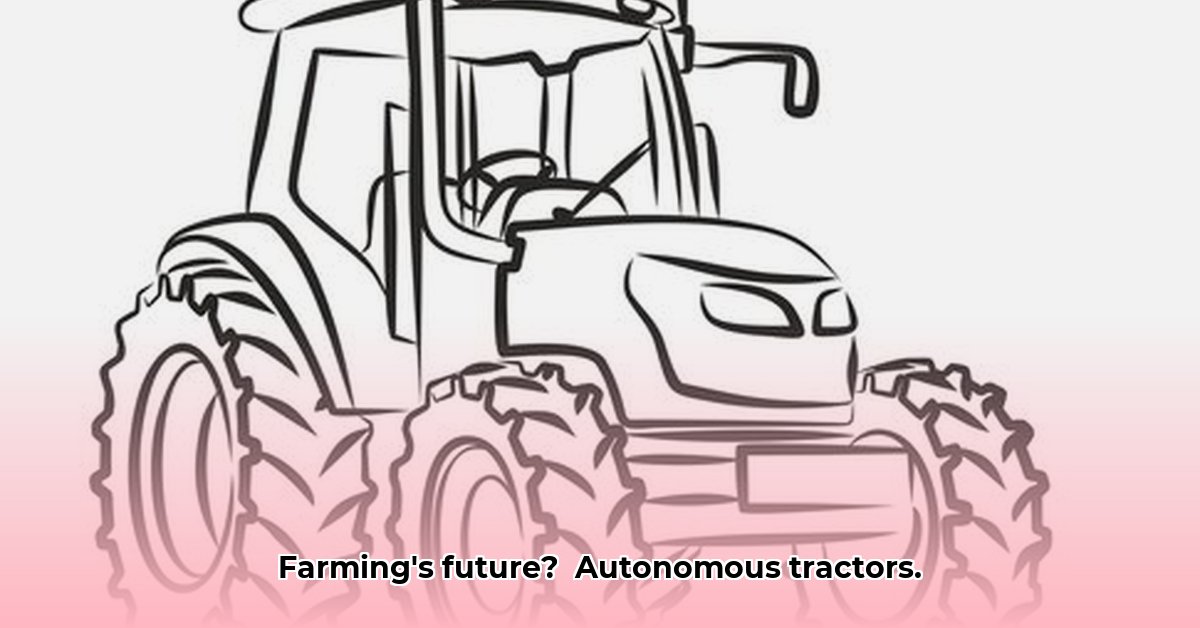
Draw Tractor: Revolutionizing Sustainable Farming
Imagine a farm where tractors navigate fields autonomously, planting seeds with pinpoint accuracy and applying pesticides only where needed. This isn't science fiction; it's the reality of precision farming powered by automated tractors. These high-tech machines are transforming agriculture, promising increased yields with drastically reduced resource consumption – less fuel, water, and pesticides, ultimately minimizing the environmental footprint. However, this technological leap presents challenges, requiring a nuanced approach to maximize benefits while mitigating potential drawbacks. This article explores the transformative potential of automated tractors, offering actionable insights for stakeholders across the agricultural landscape. For smaller farms, consider comparing sub-compact tractors.
The Precision Revolution: Why Self-Driving Tractors Matter
Automated tractors, at the heart of precision agriculture, utilize GPS, sensors, and AI to optimize resource allocation. Unlike traditional farming methods which blanket-treat fields, these smart machines deliver resources precisely where needed. This targeted approach translates to significant reductions in wasted fertilizer, pesticides, and water. "Less fertilizer means less runoff polluting our waterways," explains Dr. Emily Carter, Agricultural Engineer at the University of California, Davis. "Less pesticide means healthier ecosystems and improved biodiversity." This efficiency not only benefits farmers' bottom lines but also contributes to a healthier environment. It's a paradigm shift, moving from broad-stroke application to a more surgical, plant-by-plant approach. How much more efficient is this approach? Studies show a potential reduction in resource use by up to 40%, a compelling argument for sustainability.
The Upsides: A Greener, More Efficient Farm
The advantages of automated tractors are multifaceted:
- Resource Optimization: Precise resource application minimizes waste, leading to direct cost savings for farmers.
- Environmental Protection: Reduced chemical use minimizes soil and water pollution, contributing to a smaller carbon footprint.
- Increased Productivity: Continuous and accurate operation increases efficiency, potentially leading to larger yields.
- Improved Crop Health: Targeted resource delivery fosters healthier plants, enhancing disease resistance and overall crop quality.
The Challenges: Bumps in the Road to Automation
Despite their potential, several obstacles hinder widespread adoption:
- High Initial Investment: The substantial upfront cost presents a major barrier, especially for small-scale farms.
- Technological Integration: Integrating automated tractors into existing farm infrastructure demands significant upgrades.
- Data Security and Privacy: The vast data collected by these machines raises concerns about security and potential misuse.
- Workforce Transition: Automation necessitates retraining and reskilling programs to address potential job displacement.
The Human Factor: Farmers in the Age of Automation
Will robots replace human farmers entirely? The more accurate statement is that technology will reshape their roles. Farmers will shift from manual labor to data analysis, machine management, and strategic decision-making. Dr. John Miller, Professor of Agricultural Economics at Cornell University, highlights this transition: "The future farmer will be a skilled manager of technology, not just a field worker." This necessitates investment in training and education to equip farmers with the necessary technological proficiency. The future of farming involves a collaborative partnership between humans and machines, leveraging the strengths of both.
Actionable Intelligence: Steps Towards a Sustainable Future
The successful integration of automated tractors requires a collaborative effort. The following provides actionable steps for key stakeholders:
| Stakeholder | Short-Term Actions (0-1 Year) | Long-Term Actions (3-5 Years) |
|---|---|---|
| Farmers | Explore pilot programs and leasing options; participate in training workshops. | Invest in digital infrastructure; consider modular automated systems. |
| Agribusinesses | Analyze ROI; partner with technology providers. | Develop robust data management strategies; invest in farmer training. |
| Governments | Fund R&D invest in infrastructure; create supportive regulations and incentives. | Implement extensive training programs; address labor market shifts. |
| Technology Providers | Improve system integration and user interfaces; offer affordable options. | Develop adaptable solutions for diverse farming conditions; enhance data security. |
How to Mitigate Labor Market Disruptions from Automated Tractors in Sustainable Agriculture
The agricultural sector faces a critical labor shortage, threatening sustainable farming practices. Automated tractors offer a solution, but this transition requires careful planning. Addressing job displacement necessitates proactive measures, including retraining and the creation of new roles within the sector.
The Looming Labor Crisis in Agriculture
A shrinking agricultural workforce, due to aging farmers and fewer young people entering the field, poses a significant challenge to maintaining food security. Automated tractors present a potential solution to boost productivity and mitigate labor shortages. However, simply introducing these technologies isn't sufficient; strategic planning is critical to ensure a smooth transition.
Navigating the Social Impact of Automation
The introduction of automated tractors necessitates proactive measures to address potential job displacement and its impact on rural communities. Government agencies should facilitate the development of robust retraining programs focusing on skills needed for operating and maintaining this sophisticated equipment. Moreover, creating new job roles within the agricultural sector, such as data analysts, farm managers, and technology support specialists, offsets job losses. This transition requires acknowledging the human element and ensuring adequate support for workers in the face of technological change. "We must proactively invest in reskilling programs and support communities impacted by automation" states Sarah Chen, Rural Sociologist at the USDA.
Strategic Steps for a Smooth Transition
Successfully integrating automated tractors requires a phased approach:
- Assessment: Evaluate farm needs and resources. Determine tasks suitable for automation and assess budget constraints.
- Training: Invest in comprehensive training programs for existing and future agricultural workers.
- Pilot Programs: Implement small-scale pilot programs to test and refine the integration process.
- Adaptation: Remain adaptable to technological advancements and evolving farming practices.
- Community Engagement: Engage with stakeholders, including farmers, communities, and policymakers, to address concerns and ensure a collaborative transition.
Conclusion: A Sustainable Future
Automated tractors offer a path towards a more sustainable and efficient agricultural future. By acknowledging and addressing the potential labor market disruptions through proactive planning and collaboration, we can harness the power of technology to enhance food security and environmental sustainability. This transition requires a coordinated effort involving farmers, policymakers, and technology providers to ensure a just and successful transformation of the agricultural landscape.